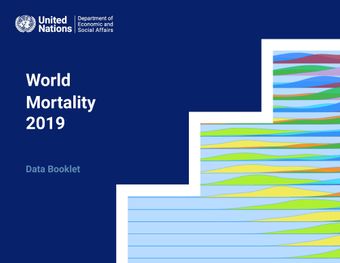World Mortality 2019
Data Booklet

Abstract
The data booklet presents key mortality indicators at the national, regional, and global level during 1950-2030. It highlights variations among countries in a number of mortality indicators: annual deaths; crude death rates; life expectancy at birth by sex; infant mortality; under-five mortality; and probabilities of dying from age 15 to age 60 and from birth to age 70. Estimates of mortality are complemented by information on the age distribution of deaths.
© United Nations
Table of Contents
Life expectancy at birth reached unprecedented high levels, but significant differences persist across regions
Average life expectancy at birth for the world was 64.2 years in 1990
Average life expectancy at birth for the world reached 72.6 years in 2019
Increases in life expectancy at birth between 1990 and 2019 were remarkable, but uneven between regions
Great success in reducing child mortality was achieved between 1990 and 2019
…but some regions are unlikely to reach the SDG target for the reduction of child mortality by 2030
Reductions of adult mortality between 1990 and 2019 were much slower than that of child mortality
More than three of every four persons worldwide now survive to 65 years
…but sub-Saharan Africa is trailing behind with less than 3 of every five persons surviving to 65 years in 2019
Key indicators
Notes
Definition of indicators
Reference
Average life expectancy at birth for the world was 64.2 years in 1990
Average life expectancy at birth for the world reached 72.6 years in 2019
Increases in life expectancy at birth between 1990 and 2019 were remarkable, but uneven between regions
Great success in reducing child mortality was achieved between 1990 and 2019
…but some regions are unlikely to reach the SDG target for the reduction of child mortality by 2030
Reductions of adult mortality between 1990 and 2019 were much slower than that of child mortality
More than three of every four persons worldwide now survive to 65 years
…but sub-Saharan Africa is trailing behind with less than 3 of every five persons surviving to 65 years in 2019
Key indicators
Notes
Definition of indicators
Reference


